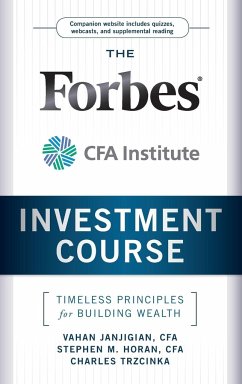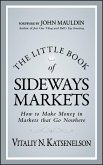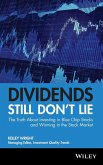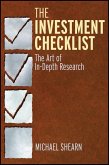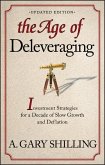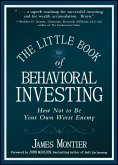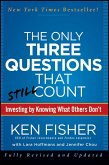Vahan Janjigian, Stephen M. Horan, Charles Trzcinka
The Forbes / Cfa Institute Investment Course
Timeless Principles for Building Wealth
Vahan Janjigian, Stephen M. Horan, Charles Trzcinka
The Forbes / Cfa Institute Investment Course
Timeless Principles for Building Wealth
- Gebundenes Buch
- Merkliste
- Auf die Merkliste
- Bewerten Bewerten
- Teilen
- Produkt teilen
- Produkterinnerung
- Produkterinnerung
The most up-to-date and all encompassing guide to investing in today's markets
From Forbes and the CFA Institute-two of the most highly respected and recognized names in the investment industry-The Forbes/CFA Institute Investment Course is an interactive roadmap to investing in today's challenging stock markets. From building capital and asset allocation and diversification to choosing a broker and reading a financial statement, The Forbes/CFA Institute Investment Course has offered investors step-by-step guidance since 1948. The course Includes advice for novices, but also accommodates…mehr
Andere Kunden interessierten sich auch für
![The Little Book of Sideways Markets The Little Book of Sideways Markets]() Vitaliy N. KatsenelsonThe Little Book of Sideways Markets19,99 €
Vitaliy N. KatsenelsonThe Little Book of Sideways Markets19,99 €![Dividends Still Don't Lie Dividends Still Don't Lie]() Kelley WrightDividends Still Don't Lie34,99 €
Kelley WrightDividends Still Don't Lie34,99 €![The Investment Checklist The Investment Checklist]() Michael ShearnThe Investment Checklist46,99 €
Michael ShearnThe Investment Checklist46,99 €![The Age of Deleveraging, Updated Edition The Age of Deleveraging, Updated Edition]() A. Gary ShillingThe Age of Deleveraging, Updated Edition17,99 €
A. Gary ShillingThe Age of Deleveraging, Updated Edition17,99 €![The Little Book of Behavioral Investing The Little Book of Behavioral Investing]() James MontierThe Little Book of Behavioral Investing19,99 €
James MontierThe Little Book of Behavioral Investing19,99 €![The Ivy Portfolio The Ivy Portfolio]() Mebane T. FaberThe Ivy Portfolio24,99 €
Mebane T. FaberThe Ivy Portfolio24,99 €![The Only Three Questions That Still Count The Only Three Questions That Still Count]() Kenneth L. FisherThe Only Three Questions That Still Count25,99 €
Kenneth L. FisherThe Only Three Questions That Still Count25,99 €-
-
-
The most up-to-date and all encompassing guide to investing in today's markets
From Forbes and the CFA Institute-two of the most highly respected and recognized names in the investment industry-The Forbes/CFA Institute Investment Course is an interactive roadmap to investing in today's challenging stock markets. From building capital and asset allocation and diversification to choosing a broker and reading a financial statement, The Forbes/CFA Institute Investment Course has offered investors step-by-step guidance since 1948. The course
Includes advice for novices, but also accommodates those who are more familiar with markets
Provides important information on fundamental analysis versus technical analysis
Details different asset classes: fixed income securities, derivatives, mutual funds, and equities
With Q&A, links to videos, expert advice, interviews with top money managers, and much more, The Forbes/CFAInstitute Investment Course is the perfect resource for anyone looking to learn about investing in today's markets.
From Forbes and the CFA Institute-two of the most highly respected and recognized names in the investment industry-The Forbes/CFA Institute Investment Course is an interactive roadmap to investing in today's challenging stock markets. From building capital and asset allocation and diversification to choosing a broker and reading a financial statement, The Forbes/CFA Institute Investment Course has offered investors step-by-step guidance since 1948. The course
Includes advice for novices, but also accommodates those who are more familiar with markets
Provides important information on fundamental analysis versus technical analysis
Details different asset classes: fixed income securities, derivatives, mutual funds, and equities
With Q&A, links to videos, expert advice, interviews with top money managers, and much more, The Forbes/CFAInstitute Investment Course is the perfect resource for anyone looking to learn about investing in today's markets.
Produktdetails
- Produktdetails
- Verlag: Wiley & Sons
- 1. Auflage
- Seitenzahl: 288
- Erscheinungstermin: 8. Februar 2011
- Englisch
- Abmessung: 235mm x 157mm x 20mm
- Gewicht: 515g
- ISBN-13: 9780470919651
- ISBN-10: 0470919655
- Artikelnr.: 31580109
- Herstellerkennzeichnung
- Libri GmbH
- Europaallee 1
- 36244 Bad Hersfeld
- gpsr@libri.de
- Verlag: Wiley & Sons
- 1. Auflage
- Seitenzahl: 288
- Erscheinungstermin: 8. Februar 2011
- Englisch
- Abmessung: 235mm x 157mm x 20mm
- Gewicht: 515g
- ISBN-13: 9780470919651
- ISBN-10: 0470919655
- Artikelnr.: 31580109
- Herstellerkennzeichnung
- Libri GmbH
- Europaallee 1
- 36244 Bad Hersfeld
- gpsr@libri.de
VAHAN JANJIGIAN is Chief Investment Officer at Greenwich Wealth Management, LLC, a SEC registered investment advisor. He is a Forbes magazine columnist and Editor of the Forbes Special Situation Survey, widely regarded as one of the best performing investment newsletters. He previously served on the faculties of several leading universities. He is a frequent guest on popular television and radio business programs and is the author of Even Buffett Isn't Perfect. STEPHEN M. HORAN is the head of professional educational content for CFA Institute and specializes in private wealth management. Prior to joining CFA Institute, he was a professor of finance at St. Bonaventure University, principal of Alesco Advisors LLC, and a financial analyst and forensic economist in private practice. He is editor of Private Wealth: Wealth Management in Practice and the author of numerous articles in leading peer-reviewed journals. Dr. Horan is a frequent columnist in the Financial Times. CHARLES TRZCINKA is the James W. & Virginia E. Cozad Chair in Finance at the Kelley School of Business, Indiana University, Bloomington. Previous positions have included the faculties of SUNY Buffalo and New York University; director of the U.S. Commerce Department's MBA program in the People's Republic of China; and senior economist with the United States Securities and Exchange Commission.
Preface xiii
Acknowledgments xvii
Chapter 1 Building Capital 1
Role of the Stock Market in Building Wealth 2
Determining Your Financial Position 3
Your Financial Inventory Guide 4
Investment Margin 11
Defining Your Goals 12
Return Requirements 13
Risk Profile 14
Life Cycle and the Risk/Return mix 15
Other Considerations 16
Asset Classes 17
Asset Allocation 20
Active versus Passive Investing 22
Diversification 23
Dollar Cost Averaging 24
Chapter Takeaways 31
Chapter 2 How Securities Markets Function 33
Role of Securities Markets 33
The Securities Exchanges 36
Over-the-Counter Markets 37
NASDAQ 38
Electronic Communication Networks 39
Stock Quotes 39
The Third Market 40
Other Markets 40
How the New York Stock Exchange Operates 41
How the NASDAQ Operates 43
From SOES to SuperMontage 44
OTC Bulletin Board and Pink Sheets 45
How the ECNs Operate 45
Crossing Systems 46
Electronic versus Floor Trading 46
Preferencing 48
Internalization 49
Chapter Takeaways 49
Chapter 3 Selecting a Broker and Trading 51
Structure of a Brokerage Firm 52
Activities of a Brokerage Firm 53
Services Offered by All Brokers 54
Full-Service versus Discount Brokers 55
Online Brokers 58
Choosing a Brokerage Firm 58
Commissions 60
Direct Purchase of Securities 62
Placing Orders 63
Odd-Lot Trading 66
Margin 67
Transaction Example 68
Settlement 69
Stock Symbols and the Ticker Tape 70
Questions to Ask Your Broker 71
Chapter Takeaways 73
Chapter 4 Tax-Favored Investment Strategies 75
Capital Gains and Dividends 75
Traditional IRAs 77
Roth IRAs 79
401(k) Plans 80
Education Savings Accounts and 529 Plans 82
Other Pension Plans 83
Mutual Funds and Taxes 85
Using Tax-Advantaged Accounts 86
Chapter Takeaways 87
Chapter 5 Reading Financial Statements 89
Income Statements 91
Balance Sheet 95
Statement of Cash Flows 99
Making Sense of the Numbers 102
Profitability Ratios 102
Asset Utilization Ratios 105
Leverage Ratios 108
Revisiting ROE 110
Liquidity Ratios 110
Market Multiples 112
Look Beyond the Numbers 114
Read the Footnotes 115
Can You Trust Financial Statements? 115
Chapter Takeaways 119
Chapter 6 Sources for Investment Information 121
Where to Obtain Information 123
Securities and Exchange Commission 124
Earnings Releases and Regulation Fair Disclosure 125
Investment Brokers and Dealers 127
Can You Trust Brokerage House Reports? 128
Investment Newsletters and Other Publications 129
Corporate Reports 130
Reading the Annual Report 130
Government Reports 131
Chapter Takeaways 131
Chapter 7 Common Stocks and Economic Indicators 133
Another Look at the Balance Sheet 133
Why Common Shares Have Value 136
Macroeconomic Factors 136
Industry-Specific Factors 140
Other Barometers 141
Evaluating Data 141
Chapter Takeaways 143
Chapter 8 Fundamental Analysis 145
Investing versus Trading 145
Passive Investing 146
Active Investing 147
Business Focus 153
Industry Outlook 154
Company Status 155
Major Trends 157
Earnings History and Outlook 158
Dividends 159
Price-Earnings and Price-Book Ratios Revisited 161
Discounted Cash Flow 163
Evaluating Management 164
Some Final Thoughts on Fundamental Analysis 165
Chapter Takeaways 165
Chapter 9 Technical Analysis 167
The Value of Charts 169
Reading Charts 171
Dow Theory 171
Head and Shoulders 175
Support and Resistance Levels 176
Trading Ranges 177
Breakaway Gaps 178
Importance of Volume 179
Other Technical Indicators 182
Time to Grow Bullish 184
Chapter Takeaways 187
Chapter 10 Fixed-Income Securities 189
Bonds 189
Understanding Bonds 190
Understanding Bond Prices 191
Bond Prices and Interest Rates 192
Call Feature 194
Credit Quality of Bonds 194
Other Issues Concerning Bonds 196
How to Buy Bonds 199
Money Market Securities 200
Preferred Stock 201
Understanding Preferred Stock 202
Tax Treatment 203
Trust Preferred Securities 204
Final Thoughts on Bonds and Preferred Stocks 204
Chapter Takeaways 205
Chapter 11 Derivatives 207
Defining Derivative Instruments 207
Futures 209
Spot Asset 209
The Futures Market 210
Delivery 211
Hedging 212
Stock Index Futures 212
Single-Stock Futures 214
Options 215
Definition of Options 216
Options Markets 216
Important Terms to Know 216
Listed Options 217
What an Option Is Worth 219
Commissions 221
To Sell or to Exercise 222
Some Popular Option Strategies 222
A Warning about Naked Option Writing 225
Chapter Takeaways 226
Chapter 12 Mutual Funds 229
An Investment Company 229
Closed-End or Open-End 230
A Short History of the Mutual Fund Industry 232
Categories of Mutual Funds 232
Advantages of Mutual Funds 237
Disadvantages of Mutual Funds 238
Mutual Fund Expenses 239
How to Choose a Fund 242
Some Final Thoughts about Mutual Funds 243
Hedge Funds 243
Chapter Takeaways 247
Chapter 13 Rules of Thumb and Key Phrases 249
Final Comments 254
Suggested Readings 255
About the Authors 257
Index 259
Acknowledgments xvii
Chapter 1 Building Capital 1
Role of the Stock Market in Building Wealth 2
Determining Your Financial Position 3
Your Financial Inventory Guide 4
Investment Margin 11
Defining Your Goals 12
Return Requirements 13
Risk Profile 14
Life Cycle and the Risk/Return mix 15
Other Considerations 16
Asset Classes 17
Asset Allocation 20
Active versus Passive Investing 22
Diversification 23
Dollar Cost Averaging 24
Chapter Takeaways 31
Chapter 2 How Securities Markets Function 33
Role of Securities Markets 33
The Securities Exchanges 36
Over-the-Counter Markets 37
NASDAQ 38
Electronic Communication Networks 39
Stock Quotes 39
The Third Market 40
Other Markets 40
How the New York Stock Exchange Operates 41
How the NASDAQ Operates 43
From SOES to SuperMontage 44
OTC Bulletin Board and Pink Sheets 45
How the ECNs Operate 45
Crossing Systems 46
Electronic versus Floor Trading 46
Preferencing 48
Internalization 49
Chapter Takeaways 49
Chapter 3 Selecting a Broker and Trading 51
Structure of a Brokerage Firm 52
Activities of a Brokerage Firm 53
Services Offered by All Brokers 54
Full-Service versus Discount Brokers 55
Online Brokers 58
Choosing a Brokerage Firm 58
Commissions 60
Direct Purchase of Securities 62
Placing Orders 63
Odd-Lot Trading 66
Margin 67
Transaction Example 68
Settlement 69
Stock Symbols and the Ticker Tape 70
Questions to Ask Your Broker 71
Chapter Takeaways 73
Chapter 4 Tax-Favored Investment Strategies 75
Capital Gains and Dividends 75
Traditional IRAs 77
Roth IRAs 79
401(k) Plans 80
Education Savings Accounts and 529 Plans 82
Other Pension Plans 83
Mutual Funds and Taxes 85
Using Tax-Advantaged Accounts 86
Chapter Takeaways 87
Chapter 5 Reading Financial Statements 89
Income Statements 91
Balance Sheet 95
Statement of Cash Flows 99
Making Sense of the Numbers 102
Profitability Ratios 102
Asset Utilization Ratios 105
Leverage Ratios 108
Revisiting ROE 110
Liquidity Ratios 110
Market Multiples 112
Look Beyond the Numbers 114
Read the Footnotes 115
Can You Trust Financial Statements? 115
Chapter Takeaways 119
Chapter 6 Sources for Investment Information 121
Where to Obtain Information 123
Securities and Exchange Commission 124
Earnings Releases and Regulation Fair Disclosure 125
Investment Brokers and Dealers 127
Can You Trust Brokerage House Reports? 128
Investment Newsletters and Other Publications 129
Corporate Reports 130
Reading the Annual Report 130
Government Reports 131
Chapter Takeaways 131
Chapter 7 Common Stocks and Economic Indicators 133
Another Look at the Balance Sheet 133
Why Common Shares Have Value 136
Macroeconomic Factors 136
Industry-Specific Factors 140
Other Barometers 141
Evaluating Data 141
Chapter Takeaways 143
Chapter 8 Fundamental Analysis 145
Investing versus Trading 145
Passive Investing 146
Active Investing 147
Business Focus 153
Industry Outlook 154
Company Status 155
Major Trends 157
Earnings History and Outlook 158
Dividends 159
Price-Earnings and Price-Book Ratios Revisited 161
Discounted Cash Flow 163
Evaluating Management 164
Some Final Thoughts on Fundamental Analysis 165
Chapter Takeaways 165
Chapter 9 Technical Analysis 167
The Value of Charts 169
Reading Charts 171
Dow Theory 171
Head and Shoulders 175
Support and Resistance Levels 176
Trading Ranges 177
Breakaway Gaps 178
Importance of Volume 179
Other Technical Indicators 182
Time to Grow Bullish 184
Chapter Takeaways 187
Chapter 10 Fixed-Income Securities 189
Bonds 189
Understanding Bonds 190
Understanding Bond Prices 191
Bond Prices and Interest Rates 192
Call Feature 194
Credit Quality of Bonds 194
Other Issues Concerning Bonds 196
How to Buy Bonds 199
Money Market Securities 200
Preferred Stock 201
Understanding Preferred Stock 202
Tax Treatment 203
Trust Preferred Securities 204
Final Thoughts on Bonds and Preferred Stocks 204
Chapter Takeaways 205
Chapter 11 Derivatives 207
Defining Derivative Instruments 207
Futures 209
Spot Asset 209
The Futures Market 210
Delivery 211
Hedging 212
Stock Index Futures 212
Single-Stock Futures 214
Options 215
Definition of Options 216
Options Markets 216
Important Terms to Know 216
Listed Options 217
What an Option Is Worth 219
Commissions 221
To Sell or to Exercise 222
Some Popular Option Strategies 222
A Warning about Naked Option Writing 225
Chapter Takeaways 226
Chapter 12 Mutual Funds 229
An Investment Company 229
Closed-End or Open-End 230
A Short History of the Mutual Fund Industry 232
Categories of Mutual Funds 232
Advantages of Mutual Funds 237
Disadvantages of Mutual Funds 238
Mutual Fund Expenses 239
How to Choose a Fund 242
Some Final Thoughts about Mutual Funds 243
Hedge Funds 243
Chapter Takeaways 247
Chapter 13 Rules of Thumb and Key Phrases 249
Final Comments 254
Suggested Readings 255
About the Authors 257
Index 259
Preface xiii
Acknowledgments xvii
Chapter 1 Building Capital 1
Role of the Stock Market in Building Wealth 2
Determining Your Financial Position 3
Your Financial Inventory Guide 4
Investment Margin 11
Defining Your Goals 12
Return Requirements 13
Risk Profile 14
Life Cycle and the Risk/Return mix 15
Other Considerations 16
Asset Classes 17
Asset Allocation 20
Active versus Passive Investing 22
Diversification 23
Dollar Cost Averaging 24
Chapter Takeaways 31
Chapter 2 How Securities Markets Function 33
Role of Securities Markets 33
The Securities Exchanges 36
Over-the-Counter Markets 37
NASDAQ 38
Electronic Communication Networks 39
Stock Quotes 39
The Third Market 40
Other Markets 40
How the New York Stock Exchange Operates 41
How the NASDAQ Operates 43
From SOES to SuperMontage 44
OTC Bulletin Board and Pink Sheets 45
How the ECNs Operate 45
Crossing Systems 46
Electronic versus Floor Trading 46
Preferencing 48
Internalization 49
Chapter Takeaways 49
Chapter 3 Selecting a Broker and Trading 51
Structure of a Brokerage Firm 52
Activities of a Brokerage Firm 53
Services Offered by All Brokers 54
Full-Service versus Discount Brokers 55
Online Brokers 58
Choosing a Brokerage Firm 58
Commissions 60
Direct Purchase of Securities 62
Placing Orders 63
Odd-Lot Trading 66
Margin 67
Transaction Example 68
Settlement 69
Stock Symbols and the Ticker Tape 70
Questions to Ask Your Broker 71
Chapter Takeaways 73
Chapter 4 Tax-Favored Investment Strategies 75
Capital Gains and Dividends 75
Traditional IRAs 77
Roth IRAs 79
401(k) Plans 80
Education Savings Accounts and 529 Plans 82
Other Pension Plans 83
Mutual Funds and Taxes 85
Using Tax-Advantaged Accounts 86
Chapter Takeaways 87
Chapter 5 Reading Financial Statements 89
Income Statements 91
Balance Sheet 95
Statement of Cash Flows 99
Making Sense of the Numbers 102
Profitability Ratios 102
Asset Utilization Ratios 105
Leverage Ratios 108
Revisiting ROE 110
Liquidity Ratios 110
Market Multiples 112
Look Beyond the Numbers 114
Read the Footnotes 115
Can You Trust Financial Statements? 115
Chapter Takeaways 119
Chapter 6 Sources for Investment Information 121
Where to Obtain Information 123
Securities and Exchange Commission 124
Earnings Releases and Regulation Fair Disclosure 125
Investment Brokers and Dealers 127
Can You Trust Brokerage House Reports? 128
Investment Newsletters and Other Publications 129
Corporate Reports 130
Reading the Annual Report 130
Government Reports 131
Chapter Takeaways 131
Chapter 7 Common Stocks and Economic Indicators 133
Another Look at the Balance Sheet 133
Why Common Shares Have Value 136
Macroeconomic Factors 136
Industry-Specific Factors 140
Other Barometers 141
Evaluating Data 141
Chapter Takeaways 143
Chapter 8 Fundamental Analysis 145
Investing versus Trading 145
Passive Investing 146
Active Investing 147
Business Focus 153
Industry Outlook 154
Company Status 155
Major Trends 157
Earnings History and Outlook 158
Dividends 159
Price-Earnings and Price-Book Ratios Revisited 161
Discounted Cash Flow 163
Evaluating Management 164
Some Final Thoughts on Fundamental Analysis 165
Chapter Takeaways 165
Chapter 9 Technical Analysis 167
The Value of Charts 169
Reading Charts 171
Dow Theory 171
Head and Shoulders 175
Support and Resistance Levels 176
Trading Ranges 177
Breakaway Gaps 178
Importance of Volume 179
Other Technical Indicators 182
Time to Grow Bullish 184
Chapter Takeaways 187
Chapter 10 Fixed-Income Securities 189
Bonds 189
Understanding Bonds 190
Understanding Bond Prices 191
Bond Prices and Interest Rates 192
Call Feature 194
Credit Quality of Bonds 194
Other Issues Concerning Bonds 196
How to Buy Bonds 199
Money Market Securities 200
Preferred Stock 201
Understanding Preferred Stock 202
Tax Treatment 203
Trust Preferred Securities 204
Final Thoughts on Bonds and Preferred Stocks 204
Chapter Takeaways 205
Chapter 11 Derivatives 207
Defining Derivative Instruments 207
Futures 209
Spot Asset 209
The Futures Market 210
Delivery 211
Hedging 212
Stock Index Futures 212
Single-Stock Futures 214
Options 215
Definition of Options 216
Options Markets 216
Important Terms to Know 216
Listed Options 217
What an Option Is Worth 219
Commissions 221
To Sell or to Exercise 222
Some Popular Option Strategies 222
A Warning about Naked Option Writing 225
Chapter Takeaways 226
Chapter 12 Mutual Funds 229
An Investment Company 229
Closed-End or Open-End 230
A Short History of the Mutual Fund Industry 232
Categories of Mutual Funds 232
Advantages of Mutual Funds 237
Disadvantages of Mutual Funds 238
Mutual Fund Expenses 239
How to Choose a Fund 242
Some Final Thoughts about Mutual Funds 243
Hedge Funds 243
Chapter Takeaways 247
Chapter 13 Rules of Thumb and Key Phrases 249
Final Comments 254
Suggested Readings 255
About the Authors 257
Index 259
Acknowledgments xvii
Chapter 1 Building Capital 1
Role of the Stock Market in Building Wealth 2
Determining Your Financial Position 3
Your Financial Inventory Guide 4
Investment Margin 11
Defining Your Goals 12
Return Requirements 13
Risk Profile 14
Life Cycle and the Risk/Return mix 15
Other Considerations 16
Asset Classes 17
Asset Allocation 20
Active versus Passive Investing 22
Diversification 23
Dollar Cost Averaging 24
Chapter Takeaways 31
Chapter 2 How Securities Markets Function 33
Role of Securities Markets 33
The Securities Exchanges 36
Over-the-Counter Markets 37
NASDAQ 38
Electronic Communication Networks 39
Stock Quotes 39
The Third Market 40
Other Markets 40
How the New York Stock Exchange Operates 41
How the NASDAQ Operates 43
From SOES to SuperMontage 44
OTC Bulletin Board and Pink Sheets 45
How the ECNs Operate 45
Crossing Systems 46
Electronic versus Floor Trading 46
Preferencing 48
Internalization 49
Chapter Takeaways 49
Chapter 3 Selecting a Broker and Trading 51
Structure of a Brokerage Firm 52
Activities of a Brokerage Firm 53
Services Offered by All Brokers 54
Full-Service versus Discount Brokers 55
Online Brokers 58
Choosing a Brokerage Firm 58
Commissions 60
Direct Purchase of Securities 62
Placing Orders 63
Odd-Lot Trading 66
Margin 67
Transaction Example 68
Settlement 69
Stock Symbols and the Ticker Tape 70
Questions to Ask Your Broker 71
Chapter Takeaways 73
Chapter 4 Tax-Favored Investment Strategies 75
Capital Gains and Dividends 75
Traditional IRAs 77
Roth IRAs 79
401(k) Plans 80
Education Savings Accounts and 529 Plans 82
Other Pension Plans 83
Mutual Funds and Taxes 85
Using Tax-Advantaged Accounts 86
Chapter Takeaways 87
Chapter 5 Reading Financial Statements 89
Income Statements 91
Balance Sheet 95
Statement of Cash Flows 99
Making Sense of the Numbers 102
Profitability Ratios 102
Asset Utilization Ratios 105
Leverage Ratios 108
Revisiting ROE 110
Liquidity Ratios 110
Market Multiples 112
Look Beyond the Numbers 114
Read the Footnotes 115
Can You Trust Financial Statements? 115
Chapter Takeaways 119
Chapter 6 Sources for Investment Information 121
Where to Obtain Information 123
Securities and Exchange Commission 124
Earnings Releases and Regulation Fair Disclosure 125
Investment Brokers and Dealers 127
Can You Trust Brokerage House Reports? 128
Investment Newsletters and Other Publications 129
Corporate Reports 130
Reading the Annual Report 130
Government Reports 131
Chapter Takeaways 131
Chapter 7 Common Stocks and Economic Indicators 133
Another Look at the Balance Sheet 133
Why Common Shares Have Value 136
Macroeconomic Factors 136
Industry-Specific Factors 140
Other Barometers 141
Evaluating Data 141
Chapter Takeaways 143
Chapter 8 Fundamental Analysis 145
Investing versus Trading 145
Passive Investing 146
Active Investing 147
Business Focus 153
Industry Outlook 154
Company Status 155
Major Trends 157
Earnings History and Outlook 158
Dividends 159
Price-Earnings and Price-Book Ratios Revisited 161
Discounted Cash Flow 163
Evaluating Management 164
Some Final Thoughts on Fundamental Analysis 165
Chapter Takeaways 165
Chapter 9 Technical Analysis 167
The Value of Charts 169
Reading Charts 171
Dow Theory 171
Head and Shoulders 175
Support and Resistance Levels 176
Trading Ranges 177
Breakaway Gaps 178
Importance of Volume 179
Other Technical Indicators 182
Time to Grow Bullish 184
Chapter Takeaways 187
Chapter 10 Fixed-Income Securities 189
Bonds 189
Understanding Bonds 190
Understanding Bond Prices 191
Bond Prices and Interest Rates 192
Call Feature 194
Credit Quality of Bonds 194
Other Issues Concerning Bonds 196
How to Buy Bonds 199
Money Market Securities 200
Preferred Stock 201
Understanding Preferred Stock 202
Tax Treatment 203
Trust Preferred Securities 204
Final Thoughts on Bonds and Preferred Stocks 204
Chapter Takeaways 205
Chapter 11 Derivatives 207
Defining Derivative Instruments 207
Futures 209
Spot Asset 209
The Futures Market 210
Delivery 211
Hedging 212
Stock Index Futures 212
Single-Stock Futures 214
Options 215
Definition of Options 216
Options Markets 216
Important Terms to Know 216
Listed Options 217
What an Option Is Worth 219
Commissions 221
To Sell or to Exercise 222
Some Popular Option Strategies 222
A Warning about Naked Option Writing 225
Chapter Takeaways 226
Chapter 12 Mutual Funds 229
An Investment Company 229
Closed-End or Open-End 230
A Short History of the Mutual Fund Industry 232
Categories of Mutual Funds 232
Advantages of Mutual Funds 237
Disadvantages of Mutual Funds 238
Mutual Fund Expenses 239
How to Choose a Fund 242
Some Final Thoughts about Mutual Funds 243
Hedge Funds 243
Chapter Takeaways 247
Chapter 13 Rules of Thumb and Key Phrases 249
Final Comments 254
Suggested Readings 255
About the Authors 257
Index 259

